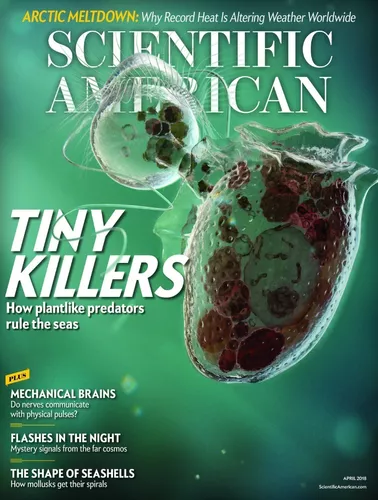Revista Scientific American Abril 2018. Inglés
$29.500
Disponibilidad: 1 in stock
Revista Scientific American Abril 2018. Inglés
ISSN: 0036-8733
Descripción
Tiny Creatures, Part Plant and Part Animal, May Control the Fate of the Planet
Mixotrophs, tiny sea creatures that hunt like animals but grow like plants, can change everything from fish populations to rates of global warming
Summer sunlight flickers through warm waters off the coast of Spain. The sea looks calm and peaceful. Near the surface, invisible to the naked eye, a swarm of microscopic plankton, some orange-pink and others dark green, swims in lazy circles, capturing the sun’s rays and using the solar energy to make nutrients through photosynthesis. Suddenly, a tentacled creature called Mesodinium at 22 microns, a giant next to some of the three micron sun gathering plankton comes zigzagging through the waters, drawn by sugars and amino acids leaking from the smaller organisms. Its tentacles shoot out and engulf the hapless green prey, or nanoflagellates, which are completely consumed and digested.
Evolution Research Could Revolutionize Cancer Therapy
Evolutionary studies indicate that the genetic changes enabling a cancer to develop arise shockingly early within the primary tumor. This discovery points to a promising new approach to therapy
Biologists have long been studying genes to understand the history of branching on the tree of life, which unites all living creatures on earth be they marmosets or microbes. One leaf on this sprawling ancestral tree, nestled among the apes, is Homo sapiens. Each individual in our species is an assemblage of cells, which cooperate to generate our body.
Revista Scientific American Abril 2018. Inglés
ISSN: 0036-8733
Descripción
Tiny Creatures, Part Plant and Part Animal, May Control the Fate of the Planet
Mixotrophs, tiny sea creatures that hunt like animals but grow like plants, can change everything from fish populations to rates of global warming
Summer sunlight flickers through warm waters off the coast of Spain. The sea looks calm and peaceful. Near the surface, invisible to the naked eye, a swarm of microscopic plankton, some orange-pink and others dark green, swims in lazy circles, capturing the sun’s rays and using the solar energy to make nutrients through photosynthesis. Suddenly, a tentacled creature called Mesodinium at 22 microns, a giant next to some of the three micron sun gathering plankton comes zigzagging through the waters, drawn by sugars and amino acids leaking from the smaller organisms. Its tentacles shoot out and engulf the hapless green prey, or nanoflagellates, which are completely consumed and digested.
Evolution Research Could Revolutionize Cancer Therapy
Evolutionary studies indicate that the genetic changes enabling a cancer to develop arise shockingly early within the primary tumor. This discovery points to a promising new approach to therapy
Biologists have long been studying genes to understand the history of branching on the tree of life, which unites all living creatures on earth be they marmosets or microbes. One leaf on this sprawling ancestral tree, nestled among the apes, is Homo sapiens. Each individual in our species is an assemblage of cells, which cooperate to generate our body.
Related products
-
Libros, revistas y cómics
Sky & Telescope # 6/2017 – The Essential Guide To Astronomy
Rated 0 out of 5$32.000 Add to cart -
Libros, revistas y cómics
Revista Entrepreneur En Español – Marzo 2019
Rated 0 out of 5$35.000 Add to cart -
Libros, revistas y cómics
Harvard Business Review 09/13. Revista De Negocios En Inglés
Rated 0 out of 5$49.900 Add to cart






